Directly Modulated Tunable Single-Mode Lasers Based on a Coupled Microcavity
Abstract
1. Introduction
2. Materials and Methods
3. Simulation and Experimental Results
3.1. Simulation of Reflection and Mode Characteristics
3.2. Static Characteristics of the Implemented Microlasers
3.3. Lorentzian Linewidth and Wavelength Tuning of HSRRL
3.4. Small-Signal Electrical Modulation Response
3.5. Large-Signal Modulation Results
4. Discussion and Improvement Paths
5. Conclusions
Author Contributions
Funding
Institutional Review Board Statement
Informed Consent Statement
Data Availability Statement
Acknowledgments
Conflicts of Interest
References
- Ji, Y.; Zhang, J. 5G optical fronthaul: Key issues, features and goals. Sci. Sin. Inf. 2017, 47, 1435–1442. [Google Scholar]
- Zhang, M. Flex Ethernet Technology and Application in 5G Mobile Transport Network. China Commun. 2021, 18, 250–258. [Google Scholar] [CrossRef]
- Xu, R.; Deng, C.S. New protection solution in native passive O-band CWDM for 5G front-haul. Telecom Eng. Tech. Stand. 2019, 32, 680–686. [Google Scholar]
- Zhang, H.; Huang, W.P. Product definition and enabling technologies for 5G wireless transceiver. ZTE Technol. J. 2018, 24, 51–53. [Google Scholar]
- Chen, B.; Meinertzhagen, I.A.; Shaw, S.R. Circadian rhythms in light-evoked responses of the fly’s compound eye, and the effects of neuromodulators 5-HT and the peptide PDF. J. Comp. Physiol. A 1999, 185, 393–404. [Google Scholar] [CrossRef]
- Cole, G.D.; Bjorlin, E.S.; Qi, C.; Chung-Yeung, C.; Shaomin, W.; Wang, C.S.; MacDonald, N.C.; Bowers, J.E. MEMS-tunable vertical-cavity SOAs. IEEE J. Quantum Electron. 2005, 41, 390–407. [Google Scholar] [CrossRef]
- Ishii, H.; Kasaya, K.; Oohashi, H.; Shibata, Y.; Yasaka, H.; Okamoto, K. Widely wavelength-tunable DFB laser array integrated with funnel combiner. IEEE J. Sel. Top. Quantum Electron. 2007, 13, 1089–1094. [Google Scholar] [CrossRef]
- Hatakeyama, H.; Naniwae, K.; Kudo, K.; Suzuki, N.; Sudo, A.; Ae, S.; Muroya, Y.; Yashiki, K.; Satoh, K.; Morimoto, T.; et al. Wavelength-selectable microarray light sources for S-, C-, and L-band WDM systems. IEEE Photonics Technol. Lett. 2003, 15, 903–905. [Google Scholar] [CrossRef]
- Suematsu, Y.; Kishino, K.; Arai, S.; Koyama, F. Dynamic Single-Mode Semiconductor-Lasers with a Distributed Reflector. Semicond. Semimet 1985, 22, 205–255. [Google Scholar] [CrossRef]
- Ishii, H.; Kasaya, K.; Oohashi, H. Spectral Linewidth Reduction in Widely Wavelength Tunable DFB Laser Array. IEEE J. Sel. Top. Quantum Electron. 2009, 15, 514–520. [Google Scholar] [CrossRef]
- Jayaraman, V.; Chuang, Z.M.; Coldren, L.A. Theory, Design, and Performance of Extended Tuning Range Semiconductor-Lasers with Sampled Gratings. IEEE J. Quantum Electron. 1993, 29, 1824–1834. [Google Scholar] [CrossRef]
- Sassi, R.; Bond, R.R.; Cairns, A.; Finlay, D.D.; Guldenring, D.; Libretti, G.; Isola, L.; Vaglio, M.; Poeta, R.; Campana, M.; et al. PDF-ECG in clinical practice: A model for long-term preservation of digital 12-lead ECG data. J. Electrocardiol. 2017, 50, 776–780. [Google Scholar] [CrossRef]
- Muller, M.S.; Hoffmann, L.; Bodendorfer, T.; Hirth, F.; Petit, F.; Plattner, M.P.; Buck, T.C.; Koch, A.W. Fiber-Optic Sensor Interrogation Based on a Widely Tunable Monolithic Laser Diode. IEEE Trans. Instrum. Meas. 2010, 59, 696–703. [Google Scholar] [CrossRef]
- Fujiwara, M.; Sasaki, M. Photon number resolving detector at telecom wavelengths: Charge integration photon detector (CIPD). IEEE J. Sel. Top. Quantum Electron. 2007, 13, 952–958. [Google Scholar] [CrossRef]
- Srivastava, A.K.; Weiershausen, W.; Dingel, B.B.; Dutta, A.K.; Kaneko, T.; Matsuura, H.; Tanizawa, K.; Uesaka, K. High-power and narrow-linewidth tunable distributed-reflector laser. In Proceedings of the Optical Metro Networks and Short-Haul Systems VIII, San Francisco, CA, USA, 16–18 February 2016. [Google Scholar]
- Nemoto, K.; Kita, T.; Yamada, H. Narrow-Spectral-Linewidth Wavelength-Tunable Laser Diode with Si Wire Waveguide Ring Resonators. Appl. Phys. Express 2012, 5, 8. [Google Scholar] [CrossRef]
- Meng, J.; Xiong, X.; Xing, H.; Jin, H.; Zhong, D.; Zou, L.; Zhao, J.; He, J.J. Full C-Band Tunable V-Cavity-Laser Based TOSA and SFP Transceiver Modules. IEEE Photonics Technol. Lett. 2017, 29, 1035–1038. [Google Scholar] [CrossRef]
- Nawrocka, M.; Lu, Q.; Guo, W.H.; Abdullaev, A.; Bello, F.; O’Callaghan, J.; Cathcart, T.; Donegan, J.F. Widely tunable six-section semiconductor laser based on etched slots. Opt. Express 2014, 22, 18949–18957. [Google Scholar] [CrossRef]
- Chen, Q.; Jiang, C.; Wang, K.; Zhang, M.; Ma, X.; Liu, Y.; Lu, Q.; Guo, W. Narrow-linewidth thermally tuned multi-channel interference widely tunable semiconductor laser with thermal tuning power below 50 mW. Photon. Res. 2020, 8, 671–676. [Google Scholar] [CrossRef]
- Jiang, C.; Chen, Q.; Wang, K.; Lu, Q.; Lu, M.; Guo, W. Narrow-linewidth thermally tuned multi-channel interference laser integrated with a SOA and spot size converter. Opt. Express 2021, 29, 13246–13255. [Google Scholar] [CrossRef]
- Ma, X.W.; Huang, Y.Z.; Yang, Y.D.; Xiao, J.L.; Weng, H.Z.; Xiao, Z.X. Mode coupling in hybrid square-rectangular lasers for single mode operation. Appl. Phys. Lett. 2016, 109, 071102. [Google Scholar] [CrossRef]
- Ma, X.W.; Huang, Y.Z.; Yang, Y.D.; Weng, H.Z.; Xiao, J.L.; Tang, M.; Du, Y. Mode and Lasing Characteristics for Hybrid Square-Rectangular Lasers. IEEE J. Sel. Top. Quantum Electron. 2017, 23, 1500409. [Google Scholar] [CrossRef]
- Wang, F.L.; Ma, X.W.; Huang, Y.Z.; Yang, Y.D.; Han, J.Y.; Xiao, J.L. Relative intensity noise in high-speed hybrid square-rectangular lasers. Photon. Res. 2018, 6, 193–197. [Google Scholar] [CrossRef]
- Hao, Y.Z.; Wang, F.L.; Tang, M.; Weng, H.Z.; Yang, Y.D.; Xiao, J.L.; Huang, Y.Z. Widely tunable single-mode lasers based on a hybrid square/rhombus-rectangular microcavity. Photonics Res. 2019, 7, 543–548. [Google Scholar] [CrossRef]
- Yang, Y.D.; Xiao, J.L.; Liu, B.W.; Huang, Y.Z. Mode characteristics and vertical radiation loss for AlGaInAs/InP microcylinder lasers. J. Opt. Soc. Am. B 2015, 32, 439–444. [Google Scholar] [CrossRef]
- Tran, M.A.; Huang, D.; Bowers, J.E. Tutorial on narrow linewidth tunable semiconductor lasers using Si/III-V heterogeneous integration. APL Photonics 2019, 4, 111101. [Google Scholar] [CrossRef]
- Westbergh, P.; Gustavsson, J.S.; Kogel, B.; Haglund, A.; Larsson, A. Impact of Photon Lifetime on High-Speed VCSEL Performance. IEEE J. Sel. Top. Quantum Electron. 2011, 17, 1603–1613. [Google Scholar] [CrossRef]
- Lv, X.-M.; Huang, Y.-Z.; Zou, L.-X.; Long, H.; Du, Y. Optimization of direct modulation rate for circular microlasers by adjusting mode Q factor. Laser Photon. Rev. 2013, 7, 818–829. [Google Scholar] [CrossRef]
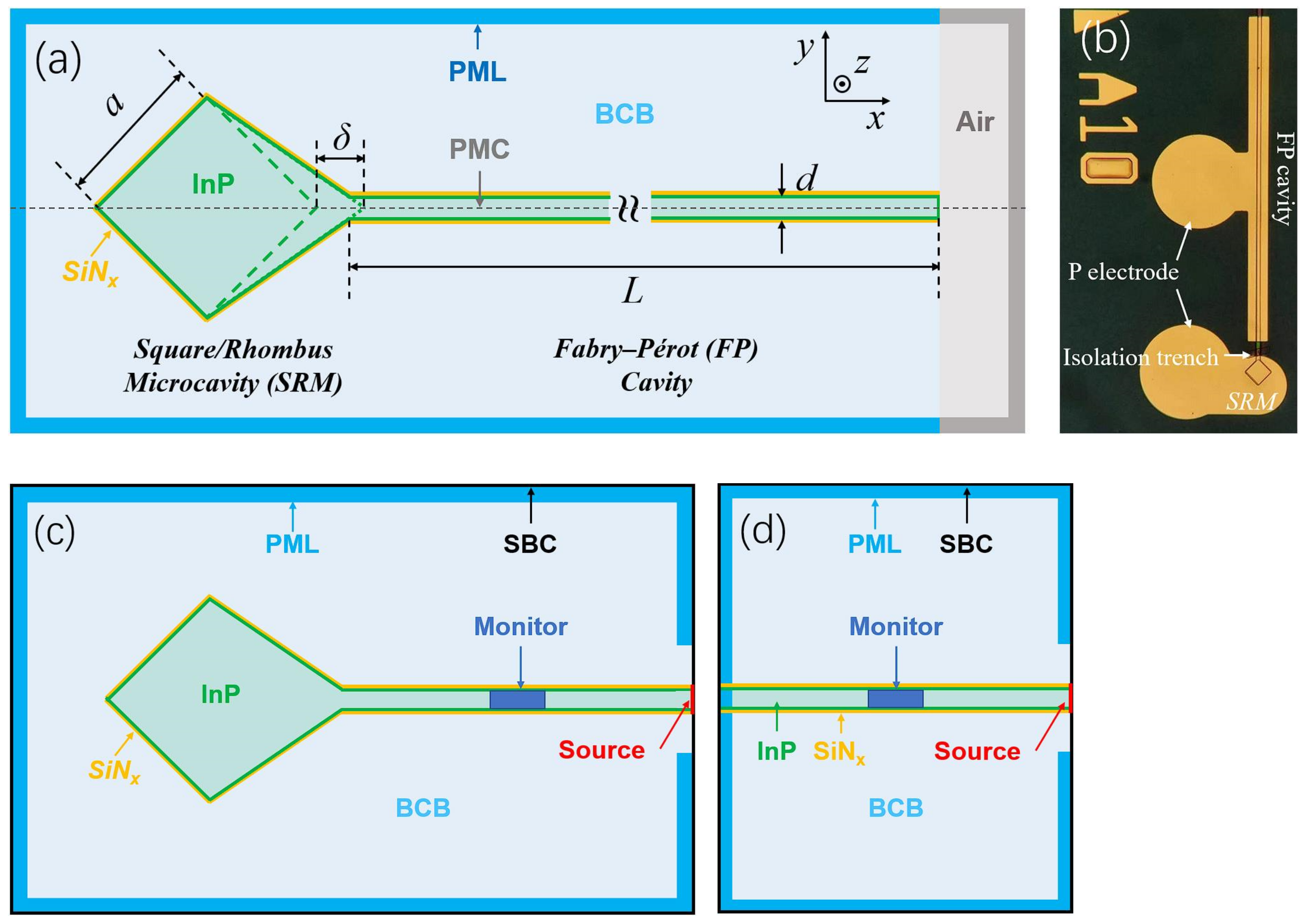
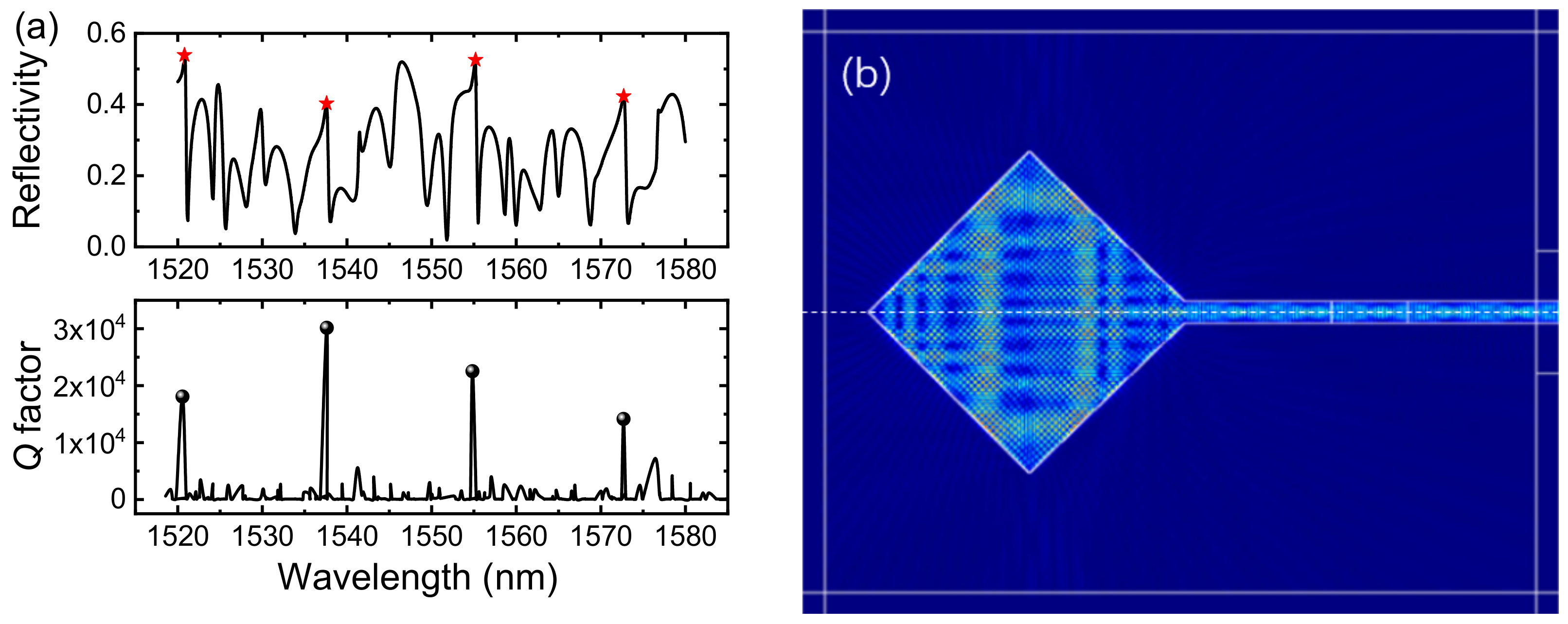
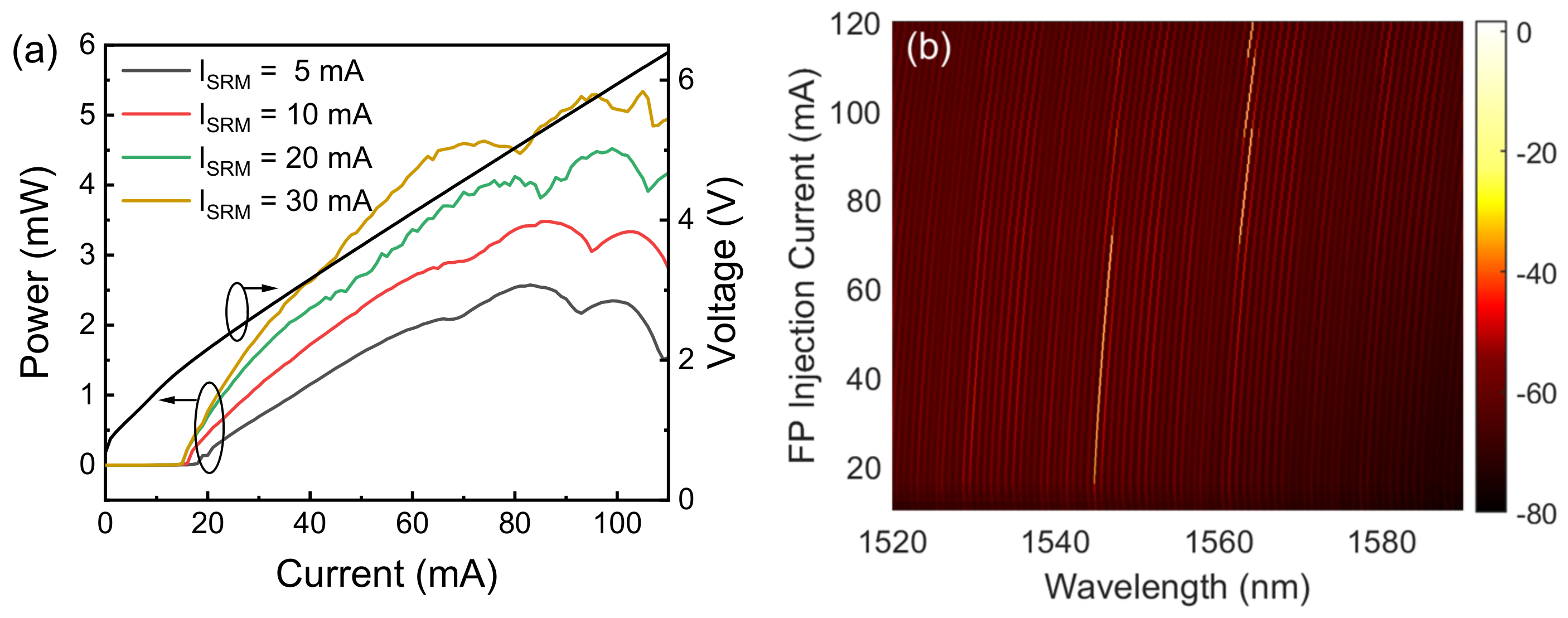
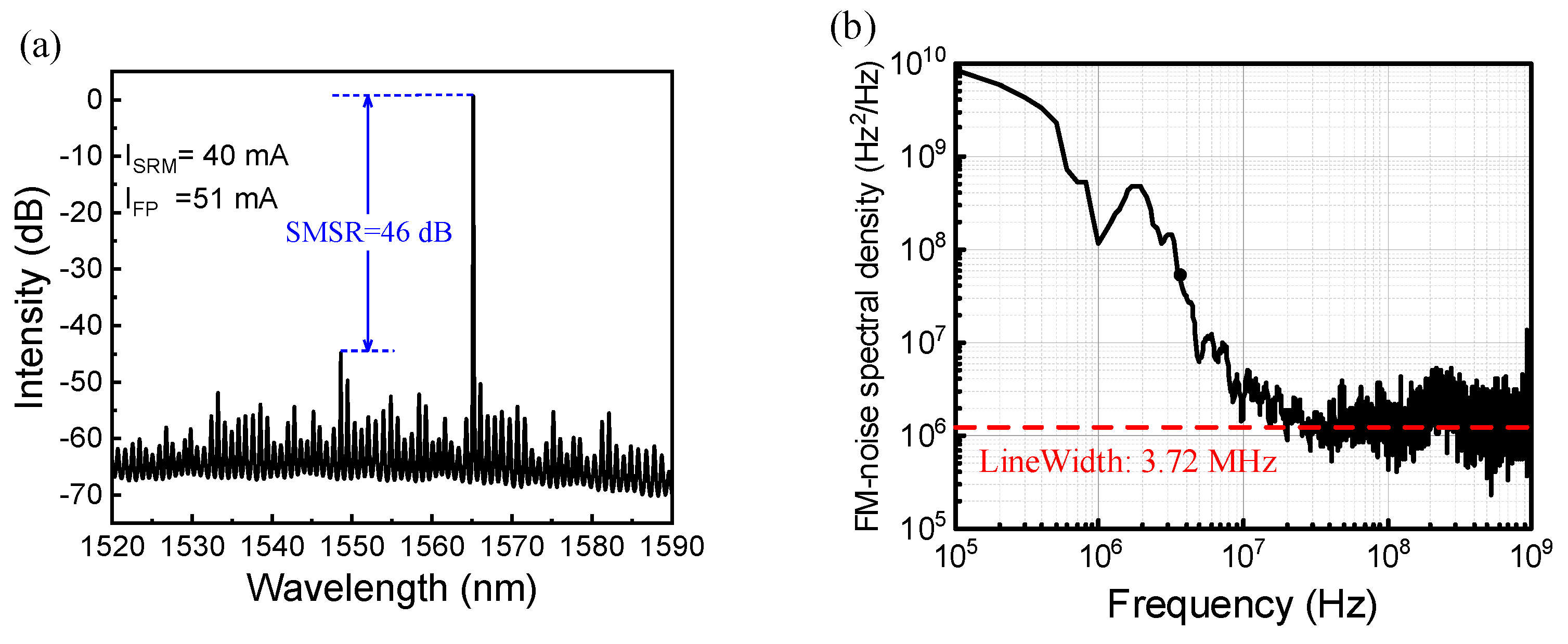

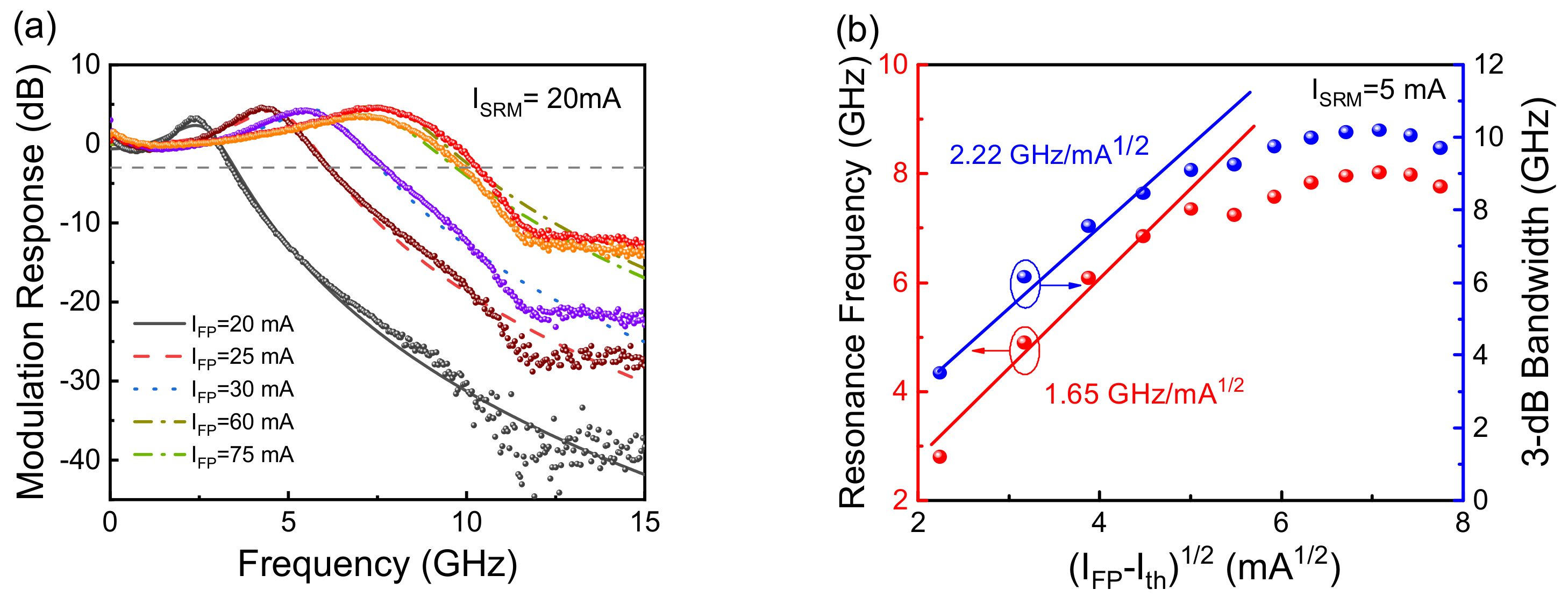

Publisher’s Note: MDPI stays neutral with regard to jurisdictional claims in published maps and institutional affiliations. |
© 2022 by the authors. Licensee MDPI, Basel, Switzerland. This article is an open access article distributed under the terms and conditions of the Creative Commons Attribution (CC BY) license (https://creativecommons.org/licenses/by/4.0/).
Share and Cite
Wang, M.-Q.; Hao, Y.-Z.; Zhang, Z.-N.; Zhang, B.; Yang, Y.-D.; Xiao, J.-L.; Teixeira, A.L.; Huang, Y.-Z. Directly Modulated Tunable Single-Mode Lasers Based on a Coupled Microcavity. Photonics 2022, 9, 827. https://doi.org/10.3390/photonics9110827
Wang M-Q, Hao Y-Z, Zhang Z-N, Zhang B, Yang Y-D, Xiao J-L, Teixeira AL, Huang Y-Z. Directly Modulated Tunable Single-Mode Lasers Based on a Coupled Microcavity. Photonics. 2022; 9(11):827. https://doi.org/10.3390/photonics9110827
Chicago/Turabian StyleWang, Miao-Qing, You-Zeng Hao, Zhen-Ning Zhang, Bin Zhang, Yue-De Yang, Jin-Long Xiao, António L. Teixeira, and Yong-Zhen Huang. 2022. "Directly Modulated Tunable Single-Mode Lasers Based on a Coupled Microcavity" Photonics 9, no. 11: 827. https://doi.org/10.3390/photonics9110827
APA StyleWang, M.-Q., Hao, Y.-Z., Zhang, Z.-N., Zhang, B., Yang, Y.-D., Xiao, J.-L., Teixeira, A. L., & Huang, Y.-Z. (2022). Directly Modulated Tunable Single-Mode Lasers Based on a Coupled Microcavity. Photonics, 9(11), 827. https://doi.org/10.3390/photonics9110827





